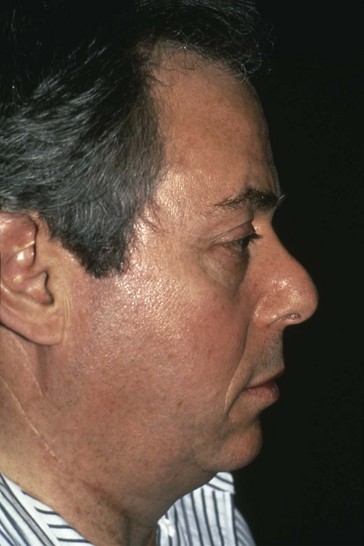Chapter 7 Achieving Optimal Tip Projection
Online Contents
In this Chapter Online at experconsult.com
Use of a Tip Punch to Harvest a Tip Graft Video 7.1
The Graft is Removed from the Punch Video 7.2
The Tip Graft is Fixed in Position Video 7.3
Use of an Onlay Tip Graft Animation 7.1
Placement of a Columella Strut Animation 7.2
The Fred Technique Animation 7.3
Reduction in Columellar Show and Increase in Nasal Projection with the Fred Technique Animation 7.4
Pearls
• The nasal tip is the most important aesthetic unit of the nose and inadequate tip projection invariably results in failure of the rhinoplasty regardless of how harmonized the other parts are.
• Inability to detect the pre-existing inadequate tip projection, some of the intraoperative maneuvers, and any postoperative changes can all result in inadequate tip projection.
• Whenever the anterocaudal septal angle is at the level of or more projected than the domes, it is very likely that the tip projection will be tangibly reduced following elimination of a dorsal hump.
• The tip support is reinforced through the use of a columella strut, a tip graft, suspension of the medial crura from the septum, or a combination of these.
• Removal of the cephalic margin of the lower lateral cartilages, a transfixion incision, reduction of the nasal spine, or lowering the caudal dorsal hump can result in reduction of tip projection.
• The different means of increasing tip projection have nuances and they cannot be used interchangeably. Each one must be used for a specific indication.
• The gain in tip projection related to the transdomal suture is associated with an increase in the infratip lobule volume.
• An onlay tip graft is indicated on a patient with insufficient infratip lobule volume and is contraindicated on a nose with excessive infratip lobule volume and a short columella.
• An onlay tip graft is not an optimal choice for a patient who has an underprojected, short nose. This patient would be a better candidate for a shield type graft.
• While the main goal of insertion of the subdomal graft is to control the distance between the domes and equalize their cephalocaudal position, this graft also lends more stability to the tip and adds to the tip definition and projection.
• A columella strut is utilized on a patient who has a short columella. This not only adds to the projection, it will result in lengthening of the columella, widening of the nasolabial angle, advancement of the subnasale caudally, and widening of the columella if a caudal medial crura suture is not used to control the width of the columella.
• A medial crura anchor suture is indicated on a patient who has a short columella. This not only results in elongation of the columella, it also rotates the tip cephalically, may widen the interdomal distance unless an interdomal suture is utilized, and may retract the columella slightly.
• It is important to unify the medial crura or insert a columella strut at the same time in order for the nasal spine and maxillary augmentation to have the greatest effectiveness on the tip projection,
• The Fred technique of advancement of the medial crura with the anterocaudal septum is suitable for the patient who has a significantly hanging columella.
The patient in Figure 7.1 appears to have an overprojected tip. However, in reality, the tip is suspended from the anterocaudal dorsum. As the caudal dorsum is lowered to eliminate the dorsal hump, the tip support will be reduced substantially. This type of perceived overprojection of the tip can be differentiated from a true overprojection by palpation of the tip and supratip structures. Whenever the anterocaudal septal angle is at the level of or more projected than the domes, it is very likely that the tip projection will be tangibly reduced following elimination of the dorsal hump. The caudal portion of the nasal tripod (see Chapter 9) is weaker than the lateral limbs and the caudal septum plays a supreme role in the stability of this part of the tripod. To maintain or improve the tip projection in such cases, one must augment the support of the central structures if the caudal dorsum is to be lowered, unless the tip is truly and significantly overprojected. The tip support is reinforced through the use of a columella strut, a tip graft, suspension of the medial crura from the septum, or a combination of these, after consideration of the other factors that will be discussed below.
As discussed in Chapter 3, many intraoperative maneuvers result in the loss of tip projection. Removal of the cephalic margin of the lower lateral cartilages can minimally reduce the tip projection in patients with a cephalic orientation of the lower lateral cartilages. A transfixion incision, by virtue of releasing the attaching fibers of the medial crura to the caudal septum, can result in the loss of tip projection, as can reduction of the nasal spine, by lowering the supporting platform for the footplates. Interruption of the lateral or medial crura, or even simply the use of the open approach, can result in the loss of tip projection.1 However, one of the maneuvers that reduces tip projection most strongly is lowering of the caudal dorsum, as mentioned above.
The means available to increase or restore tip position are listed in Box 7.1
Stay updated, free articles. Join our Telegram channel

Full access? Get Clinical Tree







